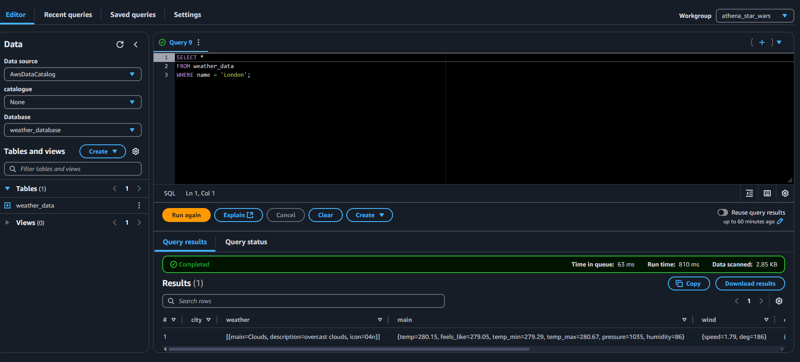 Backend Development
Backend Development
 Python Tutorial
Python Tutorial
 Building a Weather Data Analytics Pipeline with AWS and OpenWeatherMap API
Building a Weather Data Analytics Pipeline with AWS and OpenWeatherMap API
Building a Weather Data Analytics Pipeline with AWS and OpenWeatherMap API
This blog post guides you through building a weather data analytics pipeline using the OpenWeatherMap API and AWS services. The pipeline fetches weather data, stores it in S3, catalogs it with AWS Glue, and allows querying with Amazon Athena.
Project Overview
This project creates a scalable data pipeline for fetching weather data from multiple cities, storing it in AWS S3, cataloging it via AWS Glue, and enabling querying using Amazon Athena.
Initial Architecture & Architecture Diagrams


Project Structure & Prerequisites
Before starting, ensure you have:
- Docker: Installed locally.
- AWS Account: With necessary permissions (S3 buckets, Glue databases, Glue crawlers).
- OpenWeatherMap API Key: Obtained from OpenWeatherMap.
Setup Guide
-
Clone the Repository:
git clone https://github.com/Rene-Mayhrem/weather-insights.git cd weather-data-analytics
Copy after login -
Create a
.envFile: Create a.envfile in the root directory with your AWS credentials and API key:<code>AWS_ACCESS_KEY_ID=<your-access-key-id> AWS_SECRET_ACCESS_KEY=<your-secret-access-key> AWS_REGION=us-east-1 S3_BUCKET_NAME=<your-s3-bucket-name> OPENWEATHER_API_KEY=<your-openweather-api-key></code>
Copy after login -
Create
cities.json: Createcities.jsonlisting the cities:{ "cities": [ "London", "New York", "Tokyo", "Paris", "Berlin" ] }Copy after login -
Docker Compose: Build and run:
docker compose run terraform init docker compose run python
Copy after login

Usage
-
Verify Infrastructure: Check if Terraform created the AWS resources (S3, Glue database, Glue crawler) in the AWS console.
-
Verify Data Upload: Confirm the Python script uploaded weather data (JSON files) to your S3 bucket via the AWS console.

-
Run Glue Crawler: The Glue crawler should run automatically; verify its execution and data cataloging in the Glue console.
-
Query with Athena: Use the AWS Management Console to access Athena and run SQL queries on the cataloged data.

Key Components
- Docker: Provides consistent environments for Python and Terraform.
- Terraform: Manages AWS infrastructure (S3, Glue, Athena).
- Python: Fetches and uploads weather data to S3.
- Glue: Catalogs S3 data.
- Athena: Queries the cataloged data.
Conclusion
This guide helps you build a scalable weather data analytics pipeline using AWS and OpenWeatherMap. The pipeline can be easily extended to include more cities or data sources.
The above is the detailed content of Building a Weather Data Analytics Pipeline with AWS and OpenWeatherMap API. For more information, please follow other related articles on the PHP Chinese website!

Hot AI Tools

Undresser.AI Undress
AI-powered app for creating realistic nude photos

AI Clothes Remover
Online AI tool for removing clothes from photos.

Undress AI Tool
Undress images for free

Clothoff.io
AI clothes remover

AI Hentai Generator
Generate AI Hentai for free.

Hot Article

Hot Tools

Notepad++7.3.1
Easy-to-use and free code editor

SublimeText3 Chinese version
Chinese version, very easy to use

Zend Studio 13.0.1
Powerful PHP integrated development environment

Dreamweaver CS6
Visual web development tools

SublimeText3 Mac version
God-level code editing software (SublimeText3)

Hot Topics
 1378
1378
 52
52
 How to solve the permissions problem encountered when viewing Python version in Linux terminal?
Apr 01, 2025 pm 05:09 PM
How to solve the permissions problem encountered when viewing Python version in Linux terminal?
Apr 01, 2025 pm 05:09 PM
Solution to permission issues when viewing Python version in Linux terminal When you try to view Python version in Linux terminal, enter python...
 How to efficiently copy the entire column of one DataFrame into another DataFrame with different structures in Python?
Apr 01, 2025 pm 11:15 PM
How to efficiently copy the entire column of one DataFrame into another DataFrame with different structures in Python?
Apr 01, 2025 pm 11:15 PM
When using Python's pandas library, how to copy whole columns between two DataFrames with different structures is a common problem. Suppose we have two Dats...
 How to teach computer novice programming basics in project and problem-driven methods within 10 hours?
Apr 02, 2025 am 07:18 AM
How to teach computer novice programming basics in project and problem-driven methods within 10 hours?
Apr 02, 2025 am 07:18 AM
How to teach computer novice programming basics within 10 hours? If you only have 10 hours to teach computer novice some programming knowledge, what would you choose to teach...
 How to avoid being detected by the browser when using Fiddler Everywhere for man-in-the-middle reading?
Apr 02, 2025 am 07:15 AM
How to avoid being detected by the browser when using Fiddler Everywhere for man-in-the-middle reading?
Apr 02, 2025 am 07:15 AM
How to avoid being detected when using FiddlerEverywhere for man-in-the-middle readings When you use FiddlerEverywhere...
 How does Uvicorn continuously listen for HTTP requests without serving_forever()?
Apr 01, 2025 pm 10:51 PM
How does Uvicorn continuously listen for HTTP requests without serving_forever()?
Apr 01, 2025 pm 10:51 PM
How does Uvicorn continuously listen for HTTP requests? Uvicorn is a lightweight web server based on ASGI. One of its core functions is to listen for HTTP requests and proceed...
 How to dynamically create an object through a string and call its methods in Python?
Apr 01, 2025 pm 11:18 PM
How to dynamically create an object through a string and call its methods in Python?
Apr 01, 2025 pm 11:18 PM
In Python, how to dynamically create an object through a string and call its methods? This is a common programming requirement, especially if it needs to be configured or run...
 What are some popular Python libraries and their uses?
Mar 21, 2025 pm 06:46 PM
What are some popular Python libraries and their uses?
Mar 21, 2025 pm 06:46 PM
The article discusses popular Python libraries like NumPy, Pandas, Matplotlib, Scikit-learn, TensorFlow, Django, Flask, and Requests, detailing their uses in scientific computing, data analysis, visualization, machine learning, web development, and H
 What are regular expressions?
Mar 20, 2025 pm 06:25 PM
What are regular expressions?
Mar 20, 2025 pm 06:25 PM
Regular expressions are powerful tools for pattern matching and text manipulation in programming, enhancing efficiency in text processing across various applications.



